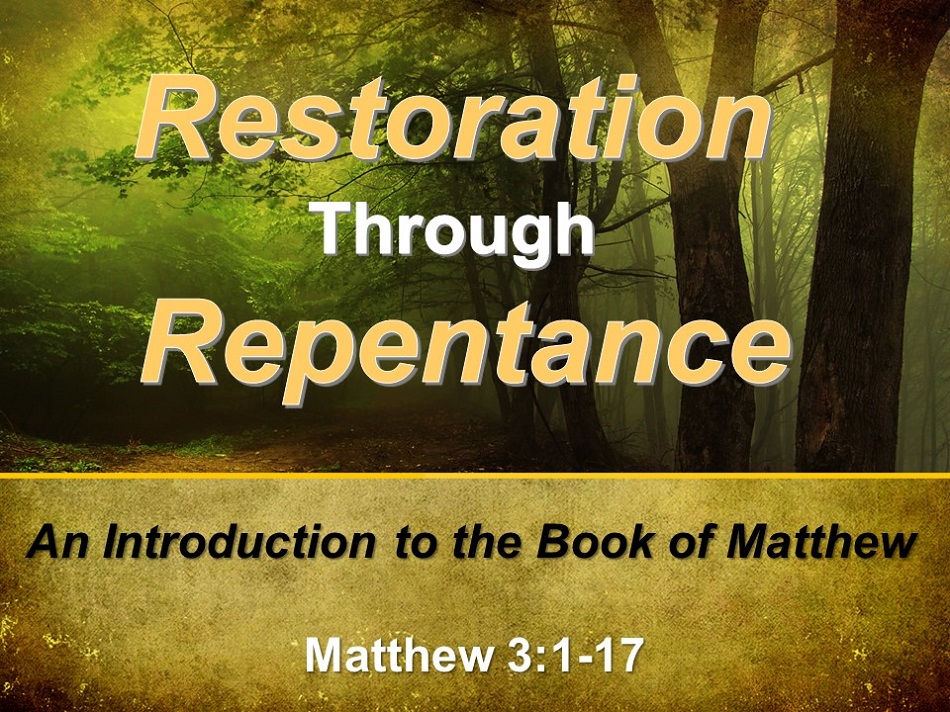
Matthew 3:1-17
The vision for this New Year is the restored joy of Jesus Christ. On Sunday night’s we’re going through a series that biblically strives to restore or renew the marriage and family. So today we begin in Matthew yet we’re going to skip the first two chapters and get into Chapter 3. The evening of February the 9th through the 12th will be our winter Bible study in which Dr. Brad Arnett, a New Testament seminary professor will walk us through the Sermon on the Mount. For those four evenings Dr. Arnett will take us through Jesus’ Blueprints of Restoration. At this point, let’s look at a little background of the book of Matthew.
Who was Matthew? Most scholars associate this book written by the former tax collector, Levi, who later became an apostle of Jesus, better known as Matthew. As a tax collector, he would have been trained to write which eventually God used to pen this book.
Possible date of writing: Most scholars date this book in the 50s and 60s AD. Jesus does mention the destruction of Jerusalem in Matthew 24, yet that is believed to be a prophesied event that had not yet occurred.
Context: An evangelistic tool written to Jews about Christ being the Messiah they’ve been looking for. Any scholars hold that the church of Antioch of Syria was the intended audience of Matthew’s gospel.
Theme: The accounts of Jesus Christ, birth, life, and ministry. The Messiah’s fulfillment of Old Testament prophecy. He is the long awaited Messiah. Matthew is one of the synoptic gospels along with Mark and Luke. These books include very similar accounts of Jesus.
Summary of Chapters 1-2
The purpose of the genealogy: To show the earthly lineage of Jesus was God’s crafting to fulfill prophesies of the coming Messiah. It is also to indicate that regardless of our failures, God can term our wasted lives through redemption to be used for His glory. The perfect example here is Rahab. Chapter 1 ends with the proclamation of the coming birth of Jesus.
Chapter 2 Shares the birth, visit from the wise men, and the escape of Herod’s scheme to kill Jesus. This was all to convey the detail in which Jesus fulfilled prophecy.
The Restored Person (3:1-6)
- Bold for Christ consistently. v.2
- Benefits from a life of simplicity. v.3
- Betters other’s lives eternally. v.6 The mark of a restored person is that they want others to be restored in Christ too! They want them to experience the joy and peace that they have.
Repentance is a big word that simply means to turn from this world and turn to Christ. Listen to what Luke recorded in Acts 3:19-20 “Repent therefore, and turn back, that your sins may be blotted out, 20 that times of refreshing may come from the presence of the Lord, and that he may send the Christ appointed for you, Jesus,”
We cannot be restored in Christ apart from repentance of sin. We must value Jesus more than we value the world.
The Renewed Purpose (3:7-12)
- The message of repentance and faith in Christ.
- The movement of the Kingdom of God.
The Redeemed Procedure (3:13-17)
- Renounce oneself vv.14-15 Of course will do this clearly in John 3:30 in which he says, “I must decrease and He must increase.”
- Rely on God only v.17 Rely on God to through faith in Christ to save you! It cannot be something in which you’re about to do yourself. What did Jesus tell Nicodemus in John 3? Jesus said, “you must be born again.” That’s not something we’re able to do apart for the miraculous work of God.
Main idea of 3:1-17. True salvation will lead to the repentance of sin, a restoration to follow Christ. We will be restored people in Christ, have a renewed purpose for the glory of Christ, and get their through a redeemed procedure of denying self and following Jesus.
